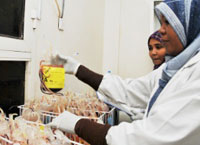“Hepatitis: It’s closer than you think. Know it. Confront it.”
This is the theme of this year's World Hepatitis Day, which takes place every year on 28 July.
World Hepatitis Day provides an opportunity to raise public awareness about viral hepatitis and focus attention on what can effectively be done for its prevention and control.
Hepatitis is an inflammation of the liver, most commonly caused by a viral infection. There are five main hepatitis viruses, referred to as types A, B, C, D and E. These five types are of greatest concern because of the burden of illness and death they cause and the potential for outbreaks and epidemic spread. In particular, types B and C lead to chronic disease in hundreds of millions of people and, together, are the most common cause of liver cirrhosis and cancer.
 Hepatitis A and E are typically caused by ingestion of contaminated food or water. Hepatitis B, C and D usually occur as a result of parenteral contact with infected body fluids. Common modes of transmission for these viruses include receipt of contaminated blood or blood products, invasive medical procedures using contaminated equipment and for hepatitis B transmission from mother to baby at birth, from family member to child, and also by sexual contact.
Hepatitis A and E are typically caused by ingestion of contaminated food or water. Hepatitis B, C and D usually occur as a result of parenteral contact with infected body fluids. Common modes of transmission for these viruses include receipt of contaminated blood or blood products, invasive medical procedures using contaminated equipment and for hepatitis B transmission from mother to baby at birth, from family member to child, and also by sexual contact.
Hepatitis can be acute or chronic and may result in serious complications and even death. Viral hepatitis affects 1 in every 12 people worldwide. It affects those close to them too. Around 500 million people worldwide are chronically infected with two types of bloodborne hepatitis: hepatitis B and C. Approximately 1 million people die each year from related complications, most commonly from liver diseases including liver cancer.
All types of viral hepatitis occur throughout the Eastern Mediterranean Region. Some countries in the Region have higher infection rates for hepatitis C and hepatitis E than any other country in the world. Approximately 17 million people in the Region are living today with hepatitis C infection and approximately 4.3 million people Region-wide are infected with hepatitis B infection every year.
Acute infection of viral hepatitis may occur with limited or no symptoms, or may include symptoms such as jaundice (yellowing of the skin and eyes), dark urine, extreme fatigue, nausea, vomiting and abdominal pain.


